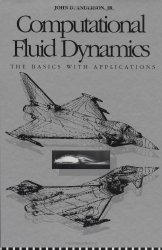Engineering Bookshelf
- Aerospace
- Biological
- Civil
- Chemical
- Environmental
- Electrical
- Materials
- Mechanical
- Petroleum
- Geoengineering
- Software

Computational Fluid Dynamics
by John AndersonPublisher: McGraw-Hill Science/Engineering/Math
ISBN: 0070016852
Check price @ amazon.com , amazon.ca , amazon.co.uk
Book Description
The Beginner's guide to Computational Fluid Dynamics. From aerospace design to applications in civil, mechanical, and chemical engineering, computational fluid dynamics (CFD) is as essential as it is complex. The most accessible introduction of its kind, Computational Fluid Dynamics: The Basics With Applications, by experienced aerospace engineer John D. Anderson, Jr., gives you a thorough grounding in the governing equations of fluid dynamics - their derivation, physical meaning, and most relevant forms; numerical discretization of the governing equations - including grids with appropriate transformations and popular techniques for solving flow problems; common CFD computer graphic techiniques; applications of CFD to 4 classic fluid dynamics problems - quasi-one-dimensional nozzle flows, two-dimensional supersonic flow, incompressible couette flow, and supersonic flow over a flat plate; state-of-the-art algorithms and applications in CFD--from the Beam and Warming Method to Second-Order Upwind Schemes and beyond.
About the Author
John D. Anderson, Jr. is the Curator of Aerodynamics at the National Air & Space Museum Smithsonian Institute and Professor Emeritus at the University of Maryland.
Customer Reviews
By winged serpent (sliding quadrants)
This is an excellent text to introduce students to CFD. The writing is very clear and enjoyable. The only complaints I have are (1) too many typos for a text published in 1995 (where is the corrected printing?) and (2) the applications and examples are almost exclusively aerodynamic. This is still the best place to begin an exploration of CFD.
By Jared Carl Workman
I am presently in my 4th year of a PhD in Astrophysics. While my background in the analytic portion of Fluid Dynamics is strong my understanding of how one discretizes and solves these equations numerically is somewhat lacking.
I picked this book up as a starting point to more complicated methods and found it to be, hands down, one of the best texts I have ever read. It presents the material in a concise, clear, and physically motivated fashion which makes learning the topic incredibly straightforward.
While this book is only a 'kicking off' point for more advanced techniques I think it is a must read for beginners and intermediate users. For the first timer to CFD the book will get you started down the right path armed with all the preliminary tools. For the more advanced user it will put aspects of the topic into an easier to understand light and perhaps shed more light on fundamentals that were presented poorly elsewhere.
I'd give it ten stars, it's allowed me to crack into the code I'm using and really understand why it works as well as having set me down the path to a more advanced level of understanding of CFD.